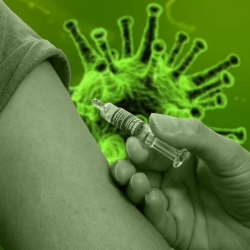 At 6.31 a.m. on Tuesday, December 8, 2020, the UK became the first country in the world to administer the COVID-19 vaccine. Just over five months earlier, I had been deployed to the NHS England and NHS Improvement COVID-19 vaccination programme to help drive the highly complex design and planning needed to bring the nation to this point. My role involved leading the set up and embedding of the Estates, Equipment, Consumables and Logistics workstream. The purpose of this was to establish and combine the new and existing infrastructure required in England to manage the distribution, regulation and administration of multiple vaccines so that all systems would be ready to vaccinate on the ‘go-live’ date.
At 6.31 a.m. on Tuesday, December 8, 2020, the UK became the first country in the world to administer the COVID-19 vaccine. Just over five months earlier, I had been deployed to the NHS England and NHS Improvement COVID-19 vaccination programme to help drive the highly complex design and planning needed to bring the nation to this point. My role involved leading the set up and embedding of the Estates, Equipment, Consumables and Logistics workstream. The purpose of this was to establish and combine the new and existing infrastructure required in England to manage the distribution, regulation and administration of multiple vaccines so that all systems would be ready to vaccinate on the ‘go-live’ date.
These vaccines, although now known throughout the world, at the time had new and emerging vaccine characteristics that were still being determined. For example, we knew that some of these vaccines, such as the Pfizer jab, would have to be kept at uncommonly ultra-low temperatures across its distribution while managing minimum waste.
It was an immense logistical and technical effort to pull the programme together and had it not been for the working practices mandated by the COVID-19 lockdown, our achievements would have been made even more difficult. So, what changed over the pandemic to allow this to happen?
[perfectpullquote align=”right” bordertop=”false” cite=”” link=”” color=”” class=”” size=””]COVID-19 ushered in the advanced use of technologies to serve real-time communications and decision making in the workplace[/perfectpullquote]
First, COVID-19 ushered in the advanced use of technologies to serve real-time communications and decision making in the workplace. Many different agencies, professions and working cultures were involved in the vaccination programme and yet all were united by common platforms with which to manage meetings, documents and communications.
This was not without its challenges, but it did provide a tremendous opportunity to expedite the efforts within the programme. My colleagues and I could often be simultaneously presenting and ‘chatting’ to a national crowd of professionals located across the country on one platform, while using a texting app with programme colleagues on another and with any spare hand we’d be responding to texts and checking emails to prioritise workstream issues.
The second factor that helped us achieve our aims was that we were able, through the norm of virtual working, to maintain critical safety in critically unsafe times. I worked with and recruited the best supply chain leads from across the country to deliver the design and planning stages of the programme. The geographic location of candidates was not an obstacle; there was no need for them to travel to an HQ, although we had one for the purpose. This meant that I could cast the net wide across the nation in bringing in experts and leaders. It meant that we could be nimble and that we were not confined in our ways of working.
The same applied for national groups led by experts and their teams who came together across the health regions to lead on programme-wide regulation, governance and the set-up of the proposed models. Everyone worked together safely, often in their own homes, and always cognisant of social distancing – even in an office we could all be at separate workstations, yet in the same meeting.
Of course, not all ways of working can be adapted virtually. We were, by the programme’s very nature, designing a physical vaccination, not a virtual jab. This meant that stress testing the planning and physically assessing how our plans across the programme fitted together were inevitable.
For instance: what were the access arrangements; how could people flow through sites in a clinically safe way; and how could site storage and facilities management be accomplished? This necessitated safety-conscious travel and congregation from time to time. Distribution to vaccination start-up centres also required someone physically present to intercept equipment and set up apparatus, as did a physical review of site governance.
Our virtual efforts to protect the physical world from COVID-19 are beginning to pay off. Since December 2020, rising numbers of the UK population have now been vaccinated and more in-person interaction beckons. However, working culture for some has changed indelibly during this period. Lockdown provided benefits that aided the establishment of the vaccination programme, and as such are being embraced by many in this new way of working.
Michael Whitmore is a research leader in health, wellbeing and work at RAND Europe. He was deployed to the NHS England and NHS Improvement COVID-19 vaccine programme in 2020 as the Estates, Equipment, Consumables and Logistics workstream leader
























May 13, 2021
The pivotal role of remote working in the journey to jab the nation
by Michael Whitmore • Comment, Flexible working
These vaccines, although now known throughout the world, at the time had new and emerging vaccine characteristics that were still being determined. For example, we knew that some of these vaccines, such as the Pfizer jab, would have to be kept at uncommonly ultra-low temperatures across its distribution while managing minimum waste.
It was an immense logistical and technical effort to pull the programme together and had it not been for the working practices mandated by the COVID-19 lockdown, our achievements would have been made even more difficult. So, what changed over the pandemic to allow this to happen?
[perfectpullquote align=”right” bordertop=”false” cite=”” link=”” color=”” class=”” size=””]COVID-19 ushered in the advanced use of technologies to serve real-time communications and decision making in the workplace[/perfectpullquote]
First, COVID-19 ushered in the advanced use of technologies to serve real-time communications and decision making in the workplace. Many different agencies, professions and working cultures were involved in the vaccination programme and yet all were united by common platforms with which to manage meetings, documents and communications.
This was not without its challenges, but it did provide a tremendous opportunity to expedite the efforts within the programme. My colleagues and I could often be simultaneously presenting and ‘chatting’ to a national crowd of professionals located across the country on one platform, while using a texting app with programme colleagues on another and with any spare hand we’d be responding to texts and checking emails to prioritise workstream issues.
The second factor that helped us achieve our aims was that we were able, through the norm of virtual working, to maintain critical safety in critically unsafe times. I worked with and recruited the best supply chain leads from across the country to deliver the design and planning stages of the programme. The geographic location of candidates was not an obstacle; there was no need for them to travel to an HQ, although we had one for the purpose. This meant that I could cast the net wide across the nation in bringing in experts and leaders. It meant that we could be nimble and that we were not confined in our ways of working.
The same applied for national groups led by experts and their teams who came together across the health regions to lead on programme-wide regulation, governance and the set-up of the proposed models. Everyone worked together safely, often in their own homes, and always cognisant of social distancing – even in an office we could all be at separate workstations, yet in the same meeting.
Of course, not all ways of working can be adapted virtually. We were, by the programme’s very nature, designing a physical vaccination, not a virtual jab. This meant that stress testing the planning and physically assessing how our plans across the programme fitted together were inevitable.
For instance: what were the access arrangements; how could people flow through sites in a clinically safe way; and how could site storage and facilities management be accomplished? This necessitated safety-conscious travel and congregation from time to time. Distribution to vaccination start-up centres also required someone physically present to intercept equipment and set up apparatus, as did a physical review of site governance.
Our virtual efforts to protect the physical world from COVID-19 are beginning to pay off. Since December 2020, rising numbers of the UK population have now been vaccinated and more in-person interaction beckons. However, working culture for some has changed indelibly during this period. Lockdown provided benefits that aided the establishment of the vaccination programme, and as such are being embraced by many in this new way of working.
Michael Whitmore is a research leader in health, wellbeing and work at RAND Europe. He was deployed to the NHS England and NHS Improvement COVID-19 vaccine programme in 2020 as the Estates, Equipment, Consumables and Logistics workstream leader